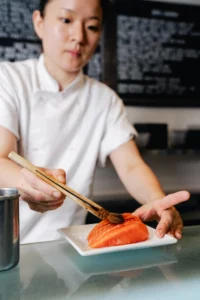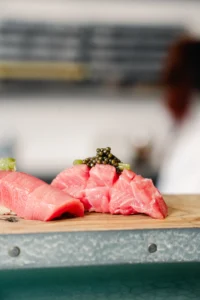Modern Japanese Dining: Tradition Meets Tokyo Modern
Modern Japanese dining shows how Tokyo’s youth are reshaping how Japan eats with creativity, tradition, and global flair. While tradition remains important, young diners now crave fresh ideas, vibrant spaces, and global flavours. As cafés, fusion menus, and playful presentations gain momentum, dining has become an evolving cultural stage.
The Rise of Modern Japanese Dining
 Young people in Tokyo have embraced cafés not just for coffee but for identity. They see these spaces as extensions of lifestyle. Cafés serve as social hubs, study corners, and creative hangouts.
Young people in Tokyo have embraced cafés not just for coffee but for identity. They see these spaces as extensions of lifestyle. Cafés serve as social hubs, study corners, and creative hangouts.
Instagram Drives Popularity
Social media plays a central role. Instagram-ready plates, latte art, and curated interiors attract crowds eager to capture every detail. Food must now look as good as it tastes. This shift has made presentation almost as vital as flavour.
Tradition in a Cup
Even while trends rise, tradition still appears. Matcha remains popular, but now baristas serve it with modern flair. Cold brews and desserts blend Japanese ingredients with international style. As a result, youth find pride in heritage while exploring new tastes.
Modern Japanese Dining and Hybrid Cuisines
Consequently, Tokyo’s dining scene thrives on experimentation. Furthermore, chefs and young entrepreneurs blend Japanese staples with flavours from abroad. As a result, this hybrid approach excites young diners who value diversity and novelty.
Ramen Meets the World
Classic ramen has transformed. Now menus feature versions inspired by Italian pasta, Mexican spice, or even vegan diets. These changes meet the demand for inclusivity and global outlook. Yet, traditional ramen shops continue to flourish, showing balance between old and new.
Sushi with a Twist
Sushi also adapts. While traditional sushi bars thrive, experimental chefs introduce bold fillings, creative sauces, and colourful plating. Youth enjoy both: one for heritage, the other for fun and surprise.
Visual Storytelling Through Food
In modern Tokyo, food tells stories. It carries cultural pride but also reflects creativity. Young people choose restaurants where visuals matter as much as flavour.
Plate as Canvas
Chefs treat plates as canvases. Bold colours, artistic shapes, and unique textures attract younger diners. They see dining as performance, not routine. Every dish becomes an opportunity to share culture online.
Instagram as the Stage
Instagram acts as the stage where these food stories unfold. Diners post their meals instantly, seeking likes and shares. This trend fuels demand for photogenic menus, shaping how restaurants design dishes.
Shifting Priorities in Modern Japanese Dining
Japanese youth value experience over excess. They spend less on formal dining yet invest in moments that feel personal and shareable.
Affordable Luxury
Instead of costly banquets, they seek affordable indulgence. A small café cake or fusion bowl can feel luxurious. Accessibility matters more than prestige.
Community and Connection
Dining also reflects community. Shared plates, themed cafés, and casual pop-ups highlight togetherness. The focus shifts from status to connection. Tradition still plays a role, but in ways that feel flexible and social.
Balancing Old and New
 Despite change, Tokyo youth show deep respect for heritage. They celebrate seasonal ingredients, ritual in preparation, and timeless flavours. Yet, they reinterpret these traditions for today.
Despite change, Tokyo youth show deep respect for heritage. They celebrate seasonal ingredients, ritual in preparation, and timeless flavours. Yet, they reinterpret these traditions for today.
Seasonal Menus Remain Strong
Restaurants still follow the rhythm of nature. Menus adapt with spring blossoms, summer vegetables, autumn harvests, and winter roots. Youth admire this respect for the seasons, even as they enjoy modern twists.
Festivals Reinvented
Food festivals also evolve. Street stalls now sell fusion snacks beside traditional skewers. Young people see these events as a chance to celebrate culture while trying something bold and new.
The Future of Modern Japanese Dining
Therefore, Tokyo’s dining future appears hybrid, visual, and community-focused. Moreover, youth lead this shift, combining global ideas with tradition.
Technology Shapes Choices
Apps and delivery platforms influence habits. Diners discover new places online, guided by ratings, photos, and hashtags. Technology bridges tradition and convenience.
Sustainability on the Menu
Sustainability also matters more. Plant-based dishes, reduced waste, and eco-friendly packaging align with youth values. Modern dining now responds to global concerns as much as local taste.
Conclusion: A Living Culture
Tokyo’s dining scene reflects Japan’s evolving identity. Youth embrace cafés, hybrid dishes, and Instagram-ready meals, yet they never forget heritage. Tradition continues, but with colour, creativity, and community at its heart. The result is a living culture – one where food remains both memory and modernity.



